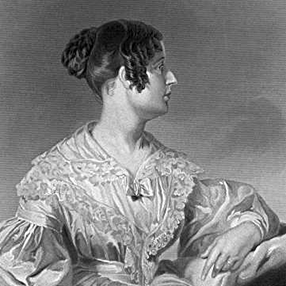I seem like one
Who treads alone
Some banquet-hall deserted,
Whose lights are fled,
Whose garlands dead,
And all but me departed.
—Thomas Moore, “Oft in the Stilly Night (Scotch Air)”
See’st thou yon gray gleaming hall,
Where the deep elm-shadows fall?
Voices that have left the earth
Long ago,
Still are murmuring round its hearth,
Soft and low:
Ever there;—yet one alone
Hath the gift to hear their tone.
Guests come thither, and depart,
Free of step, and light of heart;
Children, with sweet visions blessed,
In the haunted chambers rest;
One alone unslumbering lies
When the night hath sealed all eyes,
One quick heart and watchful ear,
Listening for those whispers clear.
See’st thou where the woodbine-flowers
O’er yon low porch hang in showers?
Startling faces of the dead,
Pale, yet sweet,
One lone woman’s entering tread
There still meet!
Some with young, smooth foreheads fair,
Faintly shining through bright hair;
Some with reverend locks of snow—
All, all buried long ago!
All, from under deep sea-waves,
Or the flowers of foreign graves,
Or the old and bannered aisle,
Where their high tombs gleam the while;
Rising, wandering, floating by,
Suddenly and silently,
Through their earthly home and place,
But amidst another race.
Wherefore, unto one alone,
Are those sounds and visions known?
Wherefore hath that spell of power
Dark and dread,
On her soul, a baleful dower,
Thus been shed?
Oh! in those deep-seeing eyes,
No strange gift of mystery lies!
She is lone where once she moved,
Fair, and happy, and beloved!
Sunny smiles were glancing round her,
Tendrils of kind hearts had bound her;
Now those silver chords are broken,
Those bright looks have left no token;
Not one trace on all the earth,
Save her memory of their mirth.
She is lone and lingering now,
Dreams have gathered o’er her brow,
Midst gay songs and children’s play,
She is dwelling far away;
Seeing what none else may see—
Haunted still her place must be!
This poem is in the public domain. Published in Poem-a-Day on October 29, 2022, by the Academy of American Poets.
“The Haunted House” was first published in National Lyrics, and Songs for Music (William Curry Jun. and Company, 1834). Caroline Franklin, editor of The Longman Anthology of Gothic Verse (Pearson Longman, 2011), writes that the poem “was probably inspired by Wavertree [Town] Hall near Liverpool,” the city in which Hemans was born. Franklin continues, “The Gothic cliché of a haunted building is deployed as a metaphor to depict a psychic state. The speaker is emptied of her own identity by the absence of her family and friends. They have departed or died, leaving her and the house alike haunted by ghostly memories.”

